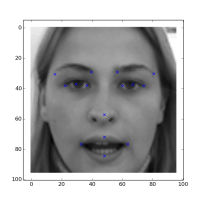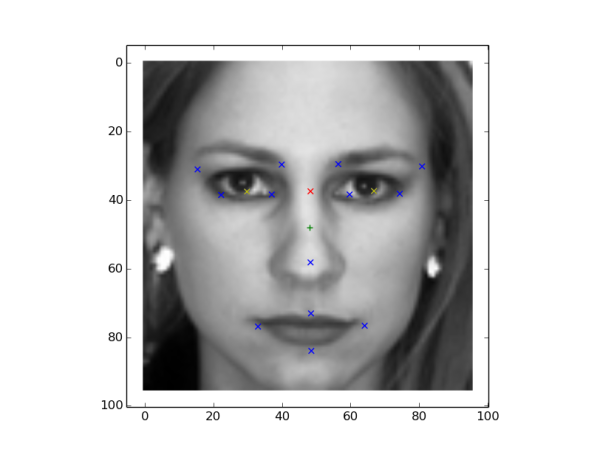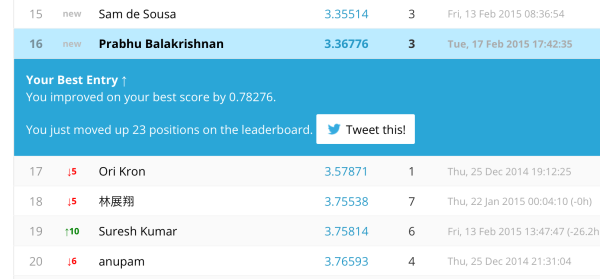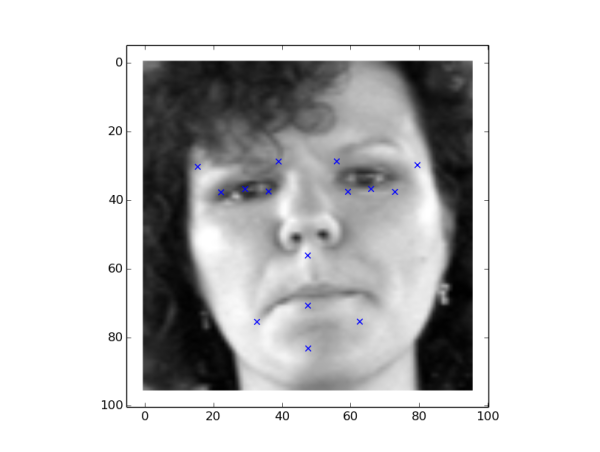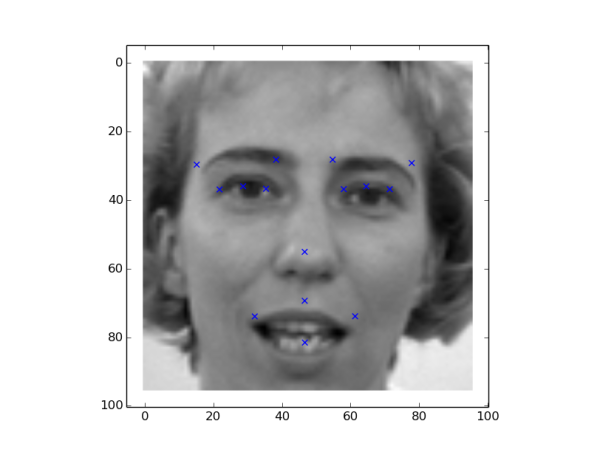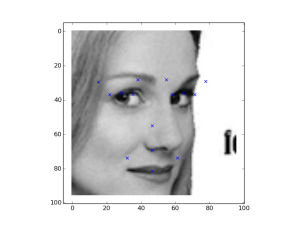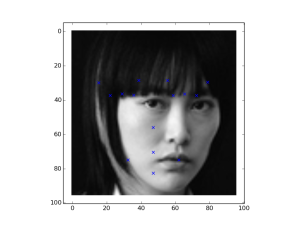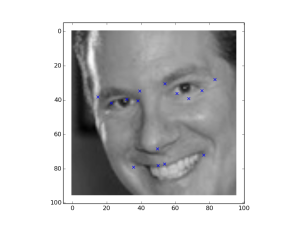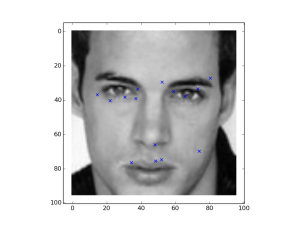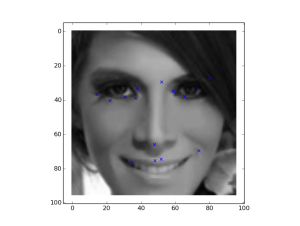Facial keypoints extraction is a challenging problem and deep learning is a hot topic and much explored area. Caffe is a popular deep learning library implementing deep learning on large datasets. Caffe is much much faster and convolutional neural networks seems to perform much better with images and can run in GPU and CPU. Running in Nvidia GPU with CUDA support is almost 20X faster than CPU. MNIST dataset classification has achieved more than 99% accuracy using convolutions in images.
The facial keypoints problem is a classic multi label regression problem. The input is (96,96) pixel grayscale images and we have to determine 30 outputs. Kaggle has a interesting facial keypoints competition: https://www.kaggle.com/c/facial-keypoints-detection
Before we move on to using caffe, lets try a simple linear regression model, to see if we can crack this problem with lowest MSE (mean square error). We will use FANN neural network library written in C as native C code is so much faster is todays CPUs than python.
What do you need
Before we proceed further, you must be familiar with
Python
Pandas
C/C++
Scikit-learn, Scikit-Image
Numpy/Scipy
CUDA from Nvidia
Linux (ubuntu)
Compiling various tools and libraries in Linux/Mac
Basic knowledge of Caffe and Deep Learning
FANN Neural Network Library
Implementing a neural network using FANN is the easiest i have seen. You can find the documentation here: http://leenissen.dk/fann/html/files/fann_train-h.html
All you have to do is dump the image data, into the format FANN is able to read and the netowrk model will be able to learn in this format. We reduce and shrink the images to 28×28 pixels and dump the data for our network to read. We use 100% of the training data without dropping the NaNs and we populate it with mean values.
A simple linear regression using FANN neural network perceptron model. after about 100 iterations produces only MSE of 0.000146. All i did was to connect inputs 24*24 size images (shrinked by 4X) to 30 outputs.
Epochs 980. Current error: 0.0001471710. Bit fail 0. Epochs 990. Current error: 0.0001470396. Bit fail 0. Epochs 1000. Current error: 0.0001469008. Bit fail 0.
As you can see, the real training error is 0.000146 * 96 * 4 = 0.056
You can find all the files in github project https://github.com/olddocks/facialkeypoints. You have to download the kaggle csv files as well.
prepare_test.py -> Dumps the images as training data for FANN to read prepare_train.py -> Prepares and dumps the test data to FANN format facial.c -> Neural network trainer ftest.c -> Testing and predictions (produces results.txt) kaggle.py -> Produces kaggle.csv (results to upload to kaggle)
To start the trainer, first you have to first compile the C code.
gcc facial.c -o facial -lfann2 -lm -I /usr/local/include/fann gcc ftest.c -o ftest -lfann2 -lm -I /usr/local/include/fann
After you run
python prepare_data.py python prepare_test.py ./facial ./ftest python kaggle.py
Lets analyze the results are like this first test images 1,2. The first shows 30 predicted against the original values. The one in brackets are difference between predicted and original, just for the understanding on how far the difference is..
Testing network.. 0 69.45/71.08(1.63) 38.68/39.58(0.91) 28.68/26.33(-2.35) 37.64/38.05(0.42) 59.64/59.26(-0.39) 36.75/36.07(-0.68) 74.55/73.94(-0.61) 35.51/34.62(-0.89) 36.81/37.48(0.67) 39.01/39.40(0.39) 21.39/22.06(0.67) 39.60/40.33(0.73) 54.88/53.30(-1.58) 29.95/29.99(0.04) 81.32/80.95(-0.37) 28.47/27.98(-0.49) 38.53/38.78(0.25) 32.26/33.30(1.04) 14.30/14.80(0.50) 33.95/35.98(2.04) 49.06/47.37(-1.69) 65.84/69.80(3.96) 70.50/72.60(2.10) 73.40/71.86(-1.54) 32.93/34.23(1.30) 77.32/77.34(0.02) 50.59/51.60(1.01) 75.66/75.96(0.31) 48.09/46.98(-1.11) 82.92/81.27(-1.64)
1 64.18/64.40(0.22) 36.78/38.50(1.73) 30.59/29.44(-1.15) 39.62/39.95(0.33) 59.07/59.26(0.19) 37.45/36.07(-1.38) 72.72/73.94(1.23) 36.10/34.62(-1.47) 37.28/37.48(0.20) 39.42/39.40(-0.02) 23.08/22.06(-1.02) 39.85/40.33(0.48) 54.15/53.30(-0.85) 31.38/29.99(-1.39) 78.95/80.95(1.99) 29.59/27.98(-1.61) 38.57/38.78(0.21) 33.13/33.30(0.17) 16.28/14.80(-1.49) 34.13/35.98(1.85) 46.06/46.74(0.68) 61.04/63.73(2.69) 68.53/72.60(4.07) 74.52/71.86(-2.65) 34.41/34.23(-0.18) 77.68/77.34(-0.34) 50.34/51.60(1.25) 75.32/75.96(0.64) 47.66/48.18(0.52) 76.92/75.27(-1.65)
2 68.75/69.26(0.51) 38.35/40.36(2.01) 29.91/28.49(-1.42) 35.56/36.19(0.63) 59.29/59.26(-0.03) 36.69/36.07(-0.63) 74.89/73.94(-0.95) 35.78/34.62(-1.16) 36.97/37.48(0.51) 38.88/39.40(0.52) 21.42/22.06(0.64) 39.23/40.33(1.10) 54.13/53.30(-0.83) 30.54/29.99(-0.55) 81.75/80.95(-0.80) 28.97/27.98(-0.99) 38.69/38.78(0.09) 32.46/33.30(0.85) 14.35/14.80(0.45) 34.06/35.98(1.92) 46.11/45.83(-0.29) 65.68/75.67(9.99) 69.40/72.60(3.20) 74.28/71.86(-2.41) 33.11/34.23(1.13) 77.40/77.34(-0.06) 49.99/51.60(1.61) 76.66/75.96(-0.70) 46.23/45.18(-1.04) 80.29/84.98(4.69) Mean Test Square Error: 0.000166
I uploaded these results to kaggle and it give mean top 16 position with 3.3 error. Wow! Not bad 🙂
P.S: I have played with this dataset using multiple neuron layers to get maximum accuracy by implementing multiple hidden layers. It seems perceptron model performed the best as far as the problem goes.
Deep Learning
Deep learning is made up multiple layers convolution and pooling layers (which are like feature extractors), finally followed by fully connected layers (IP) which in turn connects to output. The multiple pooling and convolution layers also a technique to reduce the dimensionality of images. A good tutorial is found here: http://ufldl.stanford.edu/tutorial/supervised/ConvolutionalNeuralNetwork/
We will see how caffe performs and extract the facial keypoints by running a DNN in a GPU. I have used nvidia 750ti GPU with CUDA installed in a ubuntu system.
Lets say if the image dimensions are (M,N), each convolution layer with kernel size (x,y) produces (M-x+1, N-y+1) with number of outputs. Pooling greatly bifurcates the pixel size. After each pooling with kernel size K x K, the resulting size becomes (M/k, N/k) with number of outputs
This is what we do..
1. Import the images from kaggle CSV, we drop NaNs and do preprocessing between 0 and 1 (divide by 255) for input and output labels (divide by 96), then equalize the histogram and finally dump the numpy array of the input and output labels to HDF5 files.
X is input and y is output label shape
Input Train, Test shapes (X,y): (1600, 1, 96, 96) (1600, 30) (540, 1, 96, 96) (540, 30)
2. We write a layer file with convolution and pooling layers and also a solver file with EUCLIDEAN_LOSS with 30 outputs for caffe.
3. Train the caffe and and finally predict the outputs by loading chunks of data (64 batches) into MEMORY_LAYER. This way the model can run into a small PCs with atleast 2GB of memory size.
4. To make the model more accurate, we also give the model more 15 extra features like computing euclidean distances from nose to eyes, two eye centers etc.
5. We specify RELU (to allow values > 0, plus faster converging) , Dropout layer to prevent overfitting.
6. We can calculate distances in facial points and give them as feature vector to the learning model. We will save it for later, but lets see how our small model works..
See the my git project: https://github.com/olddocks/caffe-facialkp
This is how you run the project.
python fkp.py ./facialkp python output.py
The following is a brief description of the files in the project and how to use them
fkp.py -> to write and prepare all data to hd5
./facialkp -> Run the caffe model
output.py -> Predict and plot graphs in simple 64 batches. it writes into csv
solver.prototxt – > Edit this for maximum iterations, gamma, learning rate etc.
facialkp.prototxt -> Layer file for training
facialkp_predict -> Layer file for predictions
kaggle.py -> writes kaggle output to upload (you have manually edit csv files to add header labels, if not it will not work. Sorry i am a lazy coder :()
Our 4D data dimensions
Input data (1600,1,96,96) -> Channel 1 for grayscale images Output labels (1600,30)
Our solver.prototxt, we specify GPU/CPU
net: "/home/pbu/Desktop/facialkp.prototxt" test_iter: 6 test_interval: 100 base_lr: 0.01 lr_policy: "fixed" weight_decay: 0.01 stepsize: 300 gamma: 0.1 display: 100 max_iter: 2000 momentum: 0.9 snapshot: 1000 snapshot_prefix: "/home/pbu/Desktop/tmp" solver_mode: GPU
Update: Please note i have discovered that IP layer and convolutional layers produce unexpected strange results because of the bias and weights are not initialized properly. You will need to include this code in your layer file
weight_filler {
type: "xavier"
}
bias_filler {
type: "constant"
}Our training layer file
name: "FKPReg"
layers {
name: "fkp"
top: "data"
top: "label"
type: HDF5_DATA
hdf5_data_param {
source: "train.txt"
batch_size: 64
}
include: { phase: TRAIN }
}
layers {
name: "data"
type: HDF5_DATA
top: "data"
top: "label"
hdf5_data_param {
source: "test.txt"
batch_size: 100
}
include: { phase: TEST }
}
layers {
name: "conv1"
type: CONVOLUTION
bottom: "data"
top: "conv1"
convolution_param {
num_output: 32
kernel_size: 11
stride: 2
bias_filler {
type: "constant"
value: 0.1
}
}
}
layers {
name: "relu2"
type: RELU
bottom: "conv1"
top: "conv1"
}
layers {
name: "pool1"
type: POOLING
bottom: "conv1"
top: "pool1"
pooling_param {
pool: MAX
kernel_size: 2
stride: 2
}
}
layers {
name: "conv2"
type: CONVOLUTION
bottom: "pool1"
top: "conv2"
convolution_param {
num_output: 64
pad: 2
kernel_size: 7
group: 2
bias_filler {
type: "constant"
value: 0.1
}
}
}
layers {
name: "relu2"
type: RELU
bottom: "conv2"
top: "conv2"
}
layers {
name: "pool2"
type: POOLING
bottom: "conv2"
top: "pool2"
pooling_param {
pool: MAX
kernel_size: 2
stride: 2
}
}
layers {
name: "norm2"
type: LRN
bottom: "pool2"
top: "norm2"
lrn_param {
norm_region: WITHIN_CHANNEL
local_size: 3
alpha: 5e-05
beta: 0.75
}
}
layers {
name: "conv3"
type: CONVOLUTION
bottom: "norm2"
top: "conv3"
convolution_param {
num_output: 32
pad: 1
kernel_size: 5
bias_filler {
type: "constant"
value: 0.1
}
}
}
layers {
name: "relu3"
type: RELU
bottom: "conv3"
top: "conv3"
}
layers {
name: "conv4"
type: CONVOLUTION
bottom: "conv3"
top: "conv4"
convolution_param {
num_output: 64
pad: 1
kernel_size: 5
bias_filler {
type: "constant"
value: 0.1
}
}
}
layers {
name: "relu4"
type: RELU
bottom: "conv4"
top: "conv4"
}
layers {
name: "conv5"
type: CONVOLUTION
bottom: "conv4"
top: "conv5"
convolution_param {
num_output: 32
pad: 1
kernel_size: 5
bias_filler {
type: "constant"
value: 0.1
}
}
}
layers {
name: "relu5"
type: RELU
bottom: "conv5"
top: "conv5"
}
layers {
name: "pool5"
type: POOLING
bottom: "conv5"
top: "pool5"
pooling_param {
pool: MAX
kernel_size: 4
stride: 2
}
}
layers {
name: "drop0"
type: DROPOUT
bottom: "pool5"
top: "pool5"
dropout_param {
dropout_ratio: 0.5
}
}
layers {
name: "ip1"
type: INNER_PRODUCT
bottom: "pool5"
top: "ip1"
inner_product_param {
num_output: 100
bias_filler {
type: "constant"
value: 0.1
}
}
}
layers {
name: "relu4"
type: RELU
bottom: "ip1"
top: "ip1"
}
layers {
name: "drop1"
type: DROPOUT
bottom: "ip1"
top: "ip1"
dropout_param {
dropout_ratio: 0.5
}
}
layers {
name: "ip2"
type: INNER_PRODUCT
bottom: "ip1"
top: "ip2"
inner_product_param {
num_output: 30
weight_filler {
type="xavier"
}
bias_filler {
type: "constant"
value: 0.1
}
}
}
layers {
name: "relu22"
type: RELU
bottom: "ip2"
top: "ip2"
}
layers {
name: "loss"
type: EUCLIDEAN_LOSS
bottom: "ip2"
bottom: "label"
top: "loss"
}
We run caffe and we see output like this. We can clearly see how convolution and pool layers shape the data.
I0223 18:26:03.296244 3233 net.cpp:67] Creating Layer data I0223 18:26:03.296267 3233 net.cpp:356] data -> data I0223 18:26:03.296294 3233 net.cpp:356] data -> label I0223 18:26:03.296316 3233 net.cpp:96] Setting up data I0223 18:26:03.296334 3233 hdf5_data_layer.cpp:57] Loading filename from test.txt I0223 18:26:03.296385 3233 hdf5_data_layer.cpp:69] Number of files: 1 I0223 18:26:03.296402 3233 hdf5_data_layer.cpp:29] Loading HDF5 filefacialkp-test.hd5 I0223 18:26:03.498864 3233 hdf5_data_layer.cpp:49] Successully loaded 540 rows I0223 18:26:03.498987 3233 hdf5_data_layer.cpp:81] output data size: 100,1,96,96 I0223 18:26:03.499011 3233 net.cpp:103] Top shape: 100 1 96 96 (921600) I0223 18:26:03.499032 3233 net.cpp:103] Top shape: 100 45 1 1 (4500) I0223 18:26:03.499068 3233 net.cpp:67] Creating Layer conv1 I0223 18:26:03.499091 3233 net.cpp:394] conv1 <- data I0223 18:26:03.499119 3233 net.cpp:356] conv1 -> conv1 I0223 18:26:03.499153 3233 net.cpp:96] Setting up conv1 I0223 18:26:03.499348 3233 net.cpp:103] Top shape: 100 64 44 44 (12390400) I0223 18:26:03.499392 3233 net.cpp:67] Creating Layer relu1 I0223 18:26:03.499411 3233 net.cpp:394] relu1 <- conv1 I0223 18:26:03.499433 3233 net.cpp:345] relu1 -> conv1 (in-place) I0223 18:26:03.499455 3233 net.cpp:96] Setting up relu1 I0223 18:26:03.499476 3233 net.cpp:103] Top shape: 100 64 44 44 (12390400) I0223 18:26:03.499498 3233 net.cpp:67] Creating Layer pool1 I0223 18:26:03.499516 3233 net.cpp:394] pool1 <- conv1 I0223 18:26:03.499536 3233 net.cpp:356] pool1 -> pool1 I0223 18:26:03.499557 3233 net.cpp:96] Setting up pool1 I0223 18:26:03.499583 3233 net.cpp:103] Top shape: 100 64 22 22 (3097600) I0223 18:26:03.499615 3233 net.cpp:67] Creating Layer conv2 I0223 18:26:03.499632 3233 net.cpp:394] conv2 <- pool1 I0223 18:26:03.499654 3233 net.cpp:356] conv2 -> conv2 I0223 18:26:03.499677 3233 net.cpp:96] Setting up conv2 I0223 18:26:03.500277 3233 net.cpp:103] Top shape: 100 64 22 22 (3097600) I0223 18:26:03.500363 3233 net.cpp:67] Creating Layer relu2 I0223 18:26:03.500388 3233 net.cpp:394] relu2 <- conv2 I0223 18:26:03.500412 3233 net.cpp:345] relu2 -> conv2 (in-place) I0223 18:26:03.500438 3233 net.cpp:96] Setting up relu2 I0223 18:26:03.500460 3233 net.cpp:103] Top shape: 100 64 22 22 (3097600) I0223 18:26:03.500483 3233 net.cpp:67] Creating Layer pool2 I0223 18:26:03.500500 3233 net.cpp:394] pool2 <- conv2 I0223 18:26:03.500521 3233 net.cpp:356] pool2 -> pool2 I0223 18:26:03.500545 3233 net.cpp:96] Setting up pool2 I0223 18:26:03.500569 3233 net.cpp:103] Top shape: 100 64 11 11 (774400) I0223 18:26:03.500591 3233 net.cpp:67] Creating Layer relu3 I0223 18:26:03.500607 3233 net.cpp:394] relu3 <- pool2 I0223 18:26:03.500627 3233 net.cpp:345] relu3 -> pool2 (in-place) I0223 18:26:03.500648 3233 net.cpp:96] Setting up relu3 I0223 18:26:03.500669 3233 net.cpp:103] Top shape: 100 64 11 11 (774400) I0223 18:26:03.500694 3233 net.cpp:67] Creating Layer conv3 I0223 18:26:03.500711 3233 net.cpp:394] conv3 <- pool2 I0223 18:26:03.500732 3233 net.cpp:356] conv3 -> conv3 I0223 18:26:03.500756 3233 net.cpp:96] Setting up conv3 I0223 18:26:03.501147 3233 net.cpp:103] Top shape: 100 128 11 11 (1548800) I0223 18:26:03.501216 3233 net.cpp:67] Creating Layer pool3 I0223 18:26:03.501240 3233 net.cpp:394] pool3 <- conv3 I0223 18:26:03.501266 3233 net.cpp:356] pool3 -> pool3 I0223 18:26:03.501291 3233 net.cpp:96] Setting up pool3 I0223 18:26:03.501317 3233 net.cpp:103] Top shape: 100 128 6 6 (460800) I0223 18:26:03.501343 3233 net.cpp:67] Creating Layer relu4 I0223 18:26:03.501359 3233 net.cpp:394] relu4 <- pool3 I0223 18:26:03.501379 3233 net.cpp:345] relu4 -> pool3 (in-place) I0223 18:26:03.501399 3233 net.cpp:96] Setting up relu4 I0223 18:26:03.501421 3233 net.cpp:103] Top shape: 100 128 6 6 (460800) I0223 18:26:03.501446 3233 net.cpp:67] Creating Layer conv4 I0223 18:26:03.501463 3233 net.cpp:394] conv4 <- pool3 I0223 18:26:03.501485 3233 net.cpp:356] conv4 -> conv4 I0223 18:26:03.501515 3233 net.cpp:96] Setting up conv4 I0223 18:26:03.501665 3233 net.cpp:103] Top shape: 100 100 8 8 (640000) I0223 18:26:03.501701 3233 net.cpp:67] Creating Layer drop0 I0223 18:26:03.501719 3233 net.cpp:394] drop0 <- conv4 I0223 18:26:03.501739 3233 net.cpp:345] drop0 -> conv4 (in-place) I0223 18:26:03.501761 3233 net.cpp:96] Setting up drop0 I0223 18:26:03.501780 3233 net.cpp:103] Top shape: 100 100 8 8 (640000) I0223 18:26:03.501801 3233 net.cpp:67] Creating Layer ip1 I0223 18:26:03.501818 3233 net.cpp:394] ip1 <- conv4 I0223 18:26:03.501839 3233 net.cpp:356] ip1 -> ip1 I0223 18:26:03.501924 3233 net.cpp:96] Setting up ip1 I0223 18:26:03.505934 3233 net.cpp:103] Top shape: 100 100 1 1 (10000) I0223 18:26:03.506044 3233 net.cpp:67] Creating Layer relu5 I0223 18:26:03.506064 3233 net.cpp:394] relu5 <- ip1 I0223 18:26:03.506088 3233 net.cpp:345] relu5 -> ip1 (in-place) I0223 18:26:03.506110 3233 net.cpp:96] Setting up relu5 I0223 18:26:03.506141 3233 net.cpp:103] Top shape: 100 100 1 1 (10000) I0223 18:26:03.506165 3233 net.cpp:67] Creating Layer drop1 I0223 18:26:03.506181 3233 net.cpp:394] drop1 <- ip1 I0223 18:26:03.506199 3233 net.cpp:345] drop1 -> ip1 (in-place) I0223 18:26:03.506218 3233 net.cpp:96] Setting up drop1 I0223 18:26:03.506237 3233 net.cpp:103] Top shape: 100 100 1 1 (10000) I0223 18:26:03.506265 3233 net.cpp:67] Creating Layer ip2 I0223 18:26:03.506281 3233 net.cpp:394] ip2 <- ip1 I0223 18:26:03.506302 3233 net.cpp:356] ip2 -> ip2 I0223 18:26:03.506325 3233 net.cpp:96] Setting up ip2 I0223 18:26:03.506366 3233 net.cpp:103] Top shape: 100 60 1 1 (6000) I0223 18:26:03.506391 3233 net.cpp:67] Creating Layer relu6 I0223 18:26:03.506407 3233 net.cpp:394] relu6 <- ip2 I0223 18:26:03.506425 3233 net.cpp:345] relu6 -> ip2 (in-place) I0223 18:26:03.506445 3233 net.cpp:96] Setting up relu6 I0223 18:26:03.506464 3233 net.cpp:103] Top shape: 100 60 1 1 (6000) I0223 18:26:03.506484 3233 net.cpp:67] Creating Layer drop3 I0223 18:26:03.506500 3233 net.cpp:394] drop3 <- ip2 I0223 18:26:03.506520 3233 net.cpp:345] drop3 -> ip2 (in-place) I0223 18:26:03.506538 3233 net.cpp:96] Setting up drop3 I0223 18:26:03.506554 3233 net.cpp:103] Top shape: 100 60 1 1 (6000) I0223 18:26:03.506575 3233 net.cpp:67] Creating Layer ip3 I0223 18:26:03.506592 3233 net.cpp:394] ip3 <- ip2 I0223 18:26:03.506611 3233 net.cpp:345] ip3 -> ip2 (in-place) I0223 18:26:03.506631 3233 net.cpp:96] Setting up ip3 I0223 18:26:03.506662 3233 net.cpp:103] Top shape: 100 45 1 1 (4500) I0223 18:26:03.506687 3233 net.cpp:67] Creating Layer loss I0223 18:26:03.506703 3233 net.cpp:394] loss <- ip2 I0223 18:26:03.506721 3233 net.cpp:394] loss <- label I0223 18:26:03.506742 3233 net.cpp:356] loss -> loss I0223 18:26:03.506762 3233 net.cpp:96] Setting up loss I0223 18:26:03.506783 3233 net.cpp:103] Top shape: 1 1 1 1 (1) I0223 18:26:03.506799 3233 net.cpp:109] with loss weight 1
Finally, train and test error which is 0.029*96 = 2.7, which is too high and the network is not converging and seems to learn only a bit.
I0223 19:10:08.230324 3702 solver.cpp:342] Snapshotting solver state to /home/pbu/Desktop/tmp_iter_1000.solverstate I0223 19:10:08.234257 3702 solver.cpp:264] Iteration 1000, Testing net (#0) I0223 19:10:08.384732 3702 solver.cpp:315] Test net output #0: loss = 0.0294809 (* 1 = 0.0294809 loss)
It shows that we get test error 0.029. We multiply by 96 (because we normalized it) and the result is 2.7 error, Wow, much better than the simple fann model. But wait? is it overfitting, you will know when you validate the answers with kaggle.
Lets take a look at the couple of predicted outputs from kaggle test set 0-64
Lets take a look at Set 100-164 (bit of orientation and tilt)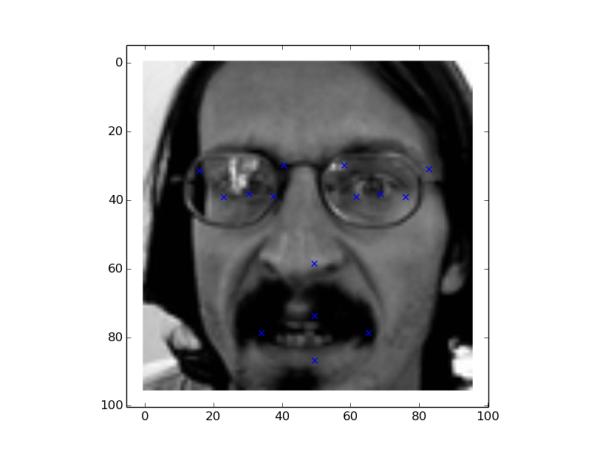
Lets take a look at the test set 200-264 (it gets more complex) and more errors in predictions.
Now more complicated images in set 400-644, flipped right and left and our model is not doing good with respect to orientation and angles of faces.
I uploaded the results to Kaggle and i got final prediction error loss of 4.6. Looks like our simple FANN model with 3.3 blows away the Deep learning with test error 2.7?
Why do you think our caffe model performing poorly? One of the reasons is because we dropped 70% of the training data because of the NaNs. We must use the data by filling up the mean and may be the error loss will improve.
So far we used the dataset dropping all NaNs. Lets see we use 100% of the dataset and see if there is any improvement in the model. We interpolate the mean values of the missing values and train the model. You can make changes in fkp.py
Train (X,y): (6000, 1, 96, 96) (6000, 30)
Test (X,y) : (1049, 1, 96, 96) (1049, 30)
After 1000 iterations, with learning rate of 0.01
I0224 19:10:10.937978 3639 solver.cpp:246] Iteration 1000, loss = 0.0102475
I0224 19:10:10.938068 3639 solver.cpp:264] Iteration 1000, Testing net (#0)
I0224 19:10:11.084893 3639 solver.cpp:315] Test net output #0: loss = 0.00789451 (* 1 = 0.00789451 loss)
After 1000 iterations, the test error is 0.00789 multiplied by 96 = 0.75, looks very minimum error compared to 2.7 (with small dataset). Lets not get fooled by the model. Let plot the x,y predictions and see if it is accurate
Looking the plots, the model predictions are far worse than the previous ones, despite a low test error.
From my observations the most accurate model was dataset created by dropping NaNs, with 500 iterations of learning rate of 0.01 (see below). Too fast learning makes the model to converge to mean which means the model is memorizing the mean. I could only squeeze to get kaggle result of 4.4 of the caffe model.
All the code files can be accessed at
Facial keypoints Fann library: https://github.com/olddocks/facialkeypoints
Deep learning in Caffe: https://github.com/olddocks/caffe-facialkp
A much better approach to facial points extraction model documented by Daniel Nouri and has high accuracy http://danielnouri.org/notes/2014/12/17/using-convolutional-neural-nets-to-detect-facial-keypoints-tutorial/
Caffe has a google public group for discussions. You can ask questions there as caffe lacks full documentation on regression and other topics: https://groups.google.com/forum/#!forum/caffe-users

